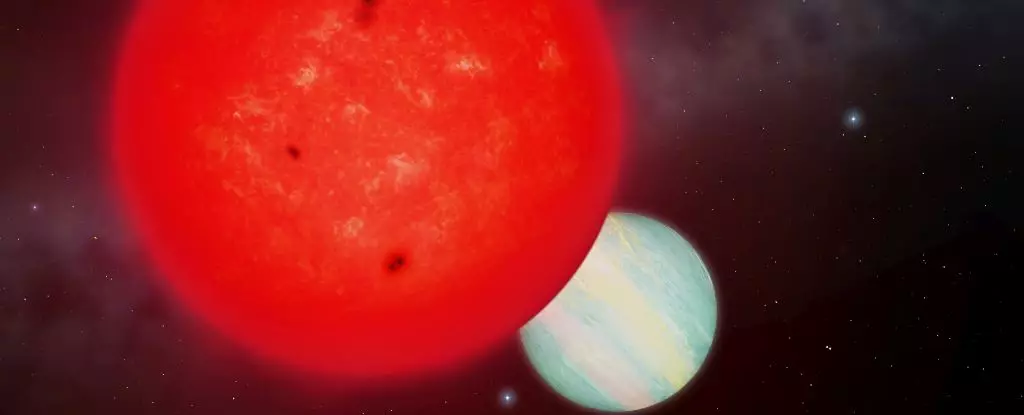Astronomers have reached a remarkable conclusion about the origins of exoplanets, most notably through the discovery of TOI-6894b—a gas giant that has ignited discussions across the astrophysics community. This exoplanet, nearly the size of Saturn, is defying long-held beliefs that small red dwarf stars lack the mass and material necessary to form large planets. Discovered in orbit around an unusually petite star, TOI-6894b represents an extraordinary case that challenges existing theories concerning planet formation.
This peculiar red dwarf star is only 21 percent of the mass of our Sun and boasts a radius that is merely 23 percent of the Sun’s size. Such low-mass stars were not thought to support the formation of monstrous gas giants, as their gravitational pull isn’t strong enough to retain the material necessary for constructing such worlds. Yet, here we are witnessing the birth of a paradigm shift in our understanding of cosmic mechanics.
Breaking Down the Myths of Planet Formation
Traditional models assert that planetary formation is a direct result of materials surrounding a star collapsing due to gravitational forces. A star’s mass typically correlates with the volume of materials in its surrounding disks, making the conception of large gas giants around small stars seem implausible—until now. TOI-6894b’s existence suggests an uncharted anomaly in astrophysical development, dismissing the notion that a star’s size limits its acumen in creating larger celestial bodies.
Astrophysicist Edward Bryant of the University of Warwick expressed his astonishment at this discovery, noting that it serves as a pivotal stepping stone for reexamining what we think we know about giant planet formation. He eloquently stated that this finding “will be a cornerstone for understanding the extremes of giant planet formation,” indicating a fundamental shift in how scientists must approach future studies of planetary systems.
Diving into the Data—Unveiling Secrets of Atmospheric Study
The methods by which TOI-6894b was discovered are equally as fascinating as the exoplanet itself. Employing the transit method, astronomers detected significant dimming of TOI-6894’s light, revealing the colossal size of the gas giant during its transit. The light emitted from the star dimmed by an astonishing 17 percent, allowing researchers to glean critical information about both the star and the planet. Such dramatic dimming provides a golden opportunity for atmospheric analysis, as starlight filters through the planet’s atmosphere during transit, enabling scientists to examine its composition.
With advanced instruments like the James Webb Space Telescope (JWST) poised for atmospheric studies, astronomers are eager to analyze the gases present in TOI-6894b’s atmosphere, with a particular expectation of detecting methane. This prospect lends itself to not only revealing the planet’s composition but also enhancing our understanding of atmospheric processes surrounding exoplanets.
Implications for Existing Theories
The surprising existence of TOI-6894b introduces significant questions concerning the conventional approaches toward understanding gas giant formation. Is it possible that we are overlooking alternative methods of planetary genesis? There are generally two prevailing theories: gradual accumulation and direct collapse from material instabilities in protoplanetary disks. With TOI-6894b’s unexpected features, neither model appears entirely satisfactory.
Astrophysicist Vincent Van Eylen from University College London reinforces the significance of this discovery, stressing that it demands a reevaluation of our current knowledge regarding how small stars can produce sizeable planets. The implications extend beyond TOI-6894b itself; researchers are motivated to search for more exoplanets and analyze whether similar patterns exist in other celestial systems.
A Paradigm Shift in Astrophysics
TOI-6894b stands as a testament to the vitality of scientific inquiry and the ever-evolving landscape of our understanding of the universe. Just when we think we have a handle on the cosmos, discoveries like that of TOI-6894b arrive to remind us of the complexities that lie beyond. The unearthing of such an exoplanet encourages a broader exploration of similar stars, urging astrophysicists to pursue further research that could unveil new planets—potentially dwarfing even these newfound giants in both mystery and size.
In an era where technology is advancing at breakneck speeds, one cannot help but look forward to what future observations may reveal about TOI-6894b and other planets orbiting low-mass stars. The answer to how such distinct celestial bodies can arise might redefine our understanding of astrophysics altogether, sculpting a more nuanced model of the universe and all its stellar inhabitants.

